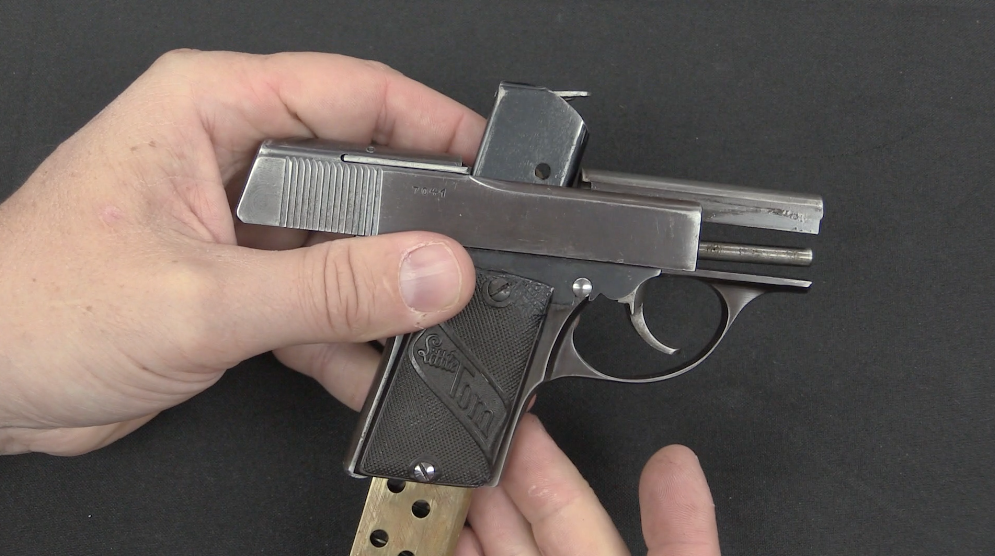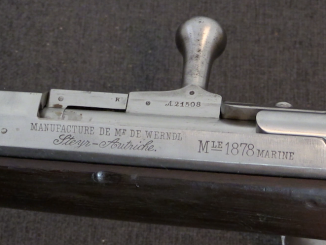The Salvatore-Dormus has the distinction of being the world’s first semiauto pistol, being patented in 1891. It is chambered for the 8mm Dormus cartridge, and holds 5 rounds in a Mannlicher type clip. Only about 50 of these pistol were made, mostly for an Austrian military trial in 1896/7 (this particular one has an 1897 Austrian military acceptance mark). The gun uses a delayed blowback action, with the shooter’s finger pressure on the trigger acting as the delaying force – not exactly an ideal system!
In Austrian trials (which were the only trials the gun entered) it was rejected in favor of the 1898 Gasser revolver, which would serve until Austria began adopting semiauto handguns in 1907. However, it does hold the distinction of being the earliest automatic pistol to actually be manufactured in more than toolroom prototype numbers (even if its military trials didn’t actually take place until after other guns had come on the market).




So would the shooter feel a distinct impulse in their trigger finger upon firing? It seems certain they would.
See also Brun-Latrige repeating pistol
http://www.littlegun.info/arme%20francaise/artisans%20a%20b/a%20brun%20latrige%20gb.htm
The cam surface on the left side of the trigger looks like it should pull something down as the trigger moves forward. If this disengages the delay mechanism, then the shooter might not feel anything when shooting. Without seeing the internals it is hard to say, but I think the cam surface is important.
If noticed, this lever uses small leverage. This means, delay element gets finger pressure only at normal squezzing level and if increased, a possibility of stopping the bolt cycling would arise. This also means, finger feels some stress that should not be ascended. IMHO.
Maybe, but if releasing the trigger merely cams a pin into the delay mechanism, then it wouldn’t take much effort. On a mouse trap you can set and release the trigger easily when the spring is compressed. Gun designers are very clever.
While this may seem dumb, there must be be some sort of disconnecter to keep from going full auto. The trigger has already been reset when the pressure on the trigger is demonstrated, which wouldn’t be the case in actual operation. What I wonder is why they built 50 finger smackers.
Seemingly, Trigger has a lever straightly fitting in a notch under the breechbot when fully squezzed. After the hammer falls, the upper tip of this lever creates a ressistance against to breechbolt backward thrust to a level which normal finger pressure stands and is pushed down by camming effect of recoiling bolt and in the same time, getting the trigger connection away off the hammer cocking notch as working like a disconnector. This, of course should be felt as a light kick over the trigger finger. The semi locking effect created by trigger lever tip seems providing sufficient delay for the rather weak round which is used by this pistol. Keeping in mind that this gun being the first sample of autoloading pistols, the disconnector work seems well thought. Besides, the inventor should have seen through the experiments that,
disconnecting the hammer and trigger engagement during the discharge, being important for keeping the gun cocked after each shot and obtaining full auto fire being very hard only via hammer follow without a hesitation and auto triggering after the forward journey of breechbolt begins. IMHO.
“Salvatore-Dormus”
Shouldn’t be Salvator-Dormus instead of Salvatore-Dormus?
I rather expect Salvator, as in Salvator-Dormus MG as there was Karl Salvator Maria Joseph Johann Baptist Philipp Jakob Januarius Ludwig von Österreich-Toscana (1839-1892) which was active in fire-arms development:
https://de.wikipedia.org/wiki/Karl_Salvator_von_Österreich-Toskana
“8mm Dormus”
Photos and dimensions: http://www.municion.org/8/8x17Dormus.htm
I am wondering why so long bullet was used? What was mass of bullet?
Duo responsible for this invention; Archduke Karl Salvator and Georg Ritter Von Dormus. Only one “Magazine Rifle” patent found for these names and no success to find or the patent of this unique pistol.
There as 1970s Thomas automatic pistol that also used “human assisted” delayed blowback – what looks like automatic safety at the rear of the grip actually pushes two “teeth” in the slide cuts, and acts as a delaying mechanism. And it was in .45 ACP…
http://www.icollector.com/Rare-A-J-Ordnance-Thomas-Semi-Automatic-Pistol_i9386326
How amazing that someone was able to design such a neat system only 26 years after our civil war ended.
Actually, there are 15.4 grains in 1 gram, so a 5.1 gramme bullet would be about 78 grains. Not knowing the muzzle velocity but assuming that it’s in the same general range as the 8mm Rast & Gasser revolver round (about 775 F/S), this would yield a muzzle energy of approx. 104 FPE.
IF, however, it was closer to the 8mm Roth-Steyr 1907 round ballistically, MV would more likely be around 900 F/S and energy would be about 140 FPE.
I might add that any MV higher than that would probably generate breech pressures high enough to make the “trigger delay” of the action difficult for anybody of roughly non-Schwarzenegger proportions to hold the trigger back even fractionally long enough to delay the breech opening. In fact, I’d expect some sprained forefingers, which might be why it was rejected by the Austrian army.
cheers
eon
The cocking mechanism movement reminds me of doing a press check on a 1911. Things progressed fast from here to the 1896 Mauser broomhandle.
Very interesting video Ian,
The .45 ACP Thomas pistol used a similar delay system. Instead of the trigger, it was in the palm of the grip, similar to a 1911 grip safety.
I’m a bit confused. Everywhere I read about this gun it says it’s a self loading pistol. My understanding is that when you shoot it automatically loads the next bullet. So you don’t have to pull the hammer back and stuff. But when I watched your video you say you have to manually pull it back to fire. I’m writing a book and I want my character to use this as her primary pistol. I really like the look of this gun and would like to bring attention to its history. 🙂